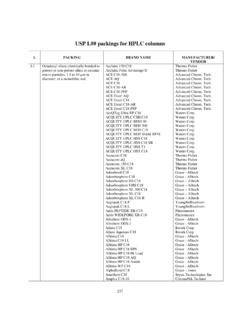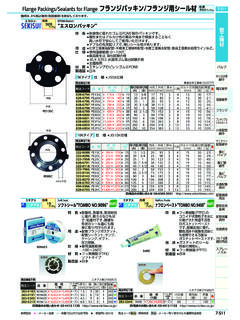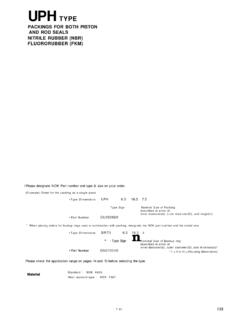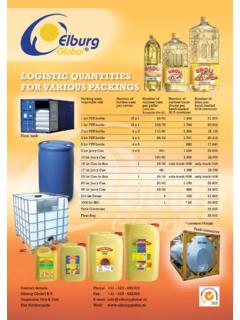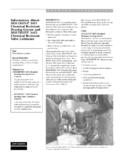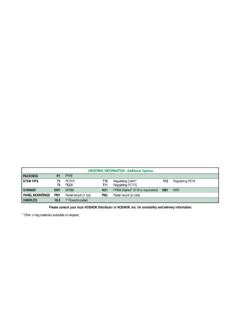Transcription of Duty/Standby versus Intermittent operation.
1 Duty/Standby versus Intermittent operation. Introduction. standby equipment is installed in order to ensure the availability of process systems or sub-systems at a high level; The configuration may be 2x100%, 3x50%, 2x75%, 4x50%, 4x33% or similar. The common operating practice is to run standby equipment intermittently with the duty equipment, so that in most cases the running hours are equalized. This practice has some benefits from the operational point of view - equipment changeover is often linked to the shift changeover, allowing some measure of ownership. - the operators `know' that both the duty and standby equipment work, because this has been demonstrated. - the equipment accumulate equal running hours, and operating experience.
2 - in some cases, startup procedures are difficult and time consuming, and so once the standby has been started up, it is convenient to leave it running. - in other cases, the equipment has to accumulate running hours in a predetermined fashion, in the case of gas turbine drivers, and the policy will be set by this requirement. The situation is somewhat different from the maintenance point of view, and the relevant points are set out in this note. Historical background. In the days before the introduction of mechanical seals, the shaft sealing arrangement for reciprocating and rotating machinery involved packed glands. These packings needed regular lubrication or they would dry up and harden, rendering them useless. In the majority of cases, the only way to lubricate these packings effectively was to run the equipment, allowing the process fluid to provide the lubrication.
3 The practice of running duty and standby equipment probably started to meet this requirement, and has continued long after the demise of the packed gland in reciprocating and rotating equipment. Functional differences Let us consider the case of a 2x100% Crude oil export pumping situation, where we have a designated duty and standby pump. The consequence of failure of the two pumps differ, as will be readily observed. If the duty pump fails in service, the other cuts in, and in most cases, there is no impact on production. ( In the case of the Export pumps, the cost of the repairs after a breakdown can be much higher than corrective work done as a result of condition monitoring. For the same reason, some preventive maintenance work is justified).
4 When we consider the consequence of failure. in the majority of cases, it is difficult to justify any significant maintenance work. As far as the standby pump is concerned, the most important failure mode is the failure to start on demand. Depending on historical failure rates relating to this failure mode, a test start can be organised at a suitable frequency, to ensure its desired availability. The next failure mode to consider is the inability to deliver the required flow at the operating pressure. The solution is to run the `test' for a reasonable length of time, say 8-24 hours, with the duty equipment shut down. A spinoff benefit from running long duration full load tests is that it will then be possible to measure condition monitoring data for the standby equipment Consider the situation when we run the pumps alternately - either pump, if running at the time may fail while running, and if on standby , may not perform the duty satisfactorily.
5 Thus both pumps need to be maintained, often with poor condition monitoring data ( since the collection of data is a hit or miss affair).The wear out rate is about equal, and the conservative policy would be to carry out time-based overhauls. This is costly and inefficient There is however one small benefit - test starts are no longer required, as alternate running is in itself a load test. Impact on failure rates Seal failures have a significant impact on overall failure rates. Their failure rate is influenced by the number of starts, rather than the duration in operation. This is because seals that are running are well lubricated, and generally show low wear rates . The worst time for a seal is the start-up condition. At start, the seal faces are dry, and it takes a short while to build up the fluid film between the faces.
6 Hence frequent starts are a major cause of wear in seals, and by reducing the number of starts, we can reduce the seal failure rate, and hence the pump failure rate. Intermittent operation results in many starts, which tends to increase failure rates, while in the case of Duty/Standby operation, the test frequencies will generally be quite low, and hence fewer startups will be required. Discussion There are two issues to consider, one relating to uptime and the second relating to costs. In the case where both pumps are run alternately, both have to taken out of service from time to time, to carry out maintenance. The work may be initiated by condition monitoring trends, or on the basis of running hours or time. In the duty / standby case, little or no maintenance is required on the duty pump, till it exhibits performance problems.
7 Work on the standby pump will only be initiated if the test run fails. Thus it can be seen that the total downtime will be much higher in the first case. While system availability may be kept up to requirements by controlling repair times strictly, there is a cost penalty associated with this policy. Due to the higher seal failure rate, in absolute terms the workload will be higher. Further, the longer the downtime on one pump, the greater the chances that the other will fail while running, hence overall, the system availability will tend to fall. In general, the system availability will be higher when designated duty and standby services are identified and the operating policy suitably aligned. The volume of maintenance work is reduced considerably by following such a policy.
8 As discussed earlier, little or no work is required on the duty pump, and the only work required on the standby is the test runs, followed by any corrective maintenance resulting from the test. Any overhaul of the duty pump will be based on performance. Secondly, seal failure rates will fall, resulting in fewer interventions and effort. This has an immediate favourable impact on maintenance costs. Alternatively, a biased unequal running policy may be adopted. In this case, the ` duty '. equipment runs for say 5 months, and the ` standby ' equipment' runs for 1 month. The advantage of this policy is that it produces the lowest number of starts, while allowing a long duration `test run' ( of 1 month!), and a test frequency in this case of 5 months.
9 The RCM logic will produce different test frequencies for each case; a common frequency could be adopted as an administrative compromise. Proposal The policy should be altered so that, the standard mode of operation is with designated duty and standby equipment, wherever redundancy exists. Further, RCM logic should be used to determine the maintenance requirements of such equipment. As an alternative, a biased unequal running policy may be adopted. In specific cases, where other considerations dictate operating policy, exceptions can be made to suit the circumstances. Benefits Reduction in maintenance costs. Increase in uptime. Drawbacks Additional office work to change maintenance and operating routines and procedures; communication to Plant staff to explain the reasons for the changes and getting their cooperation.
